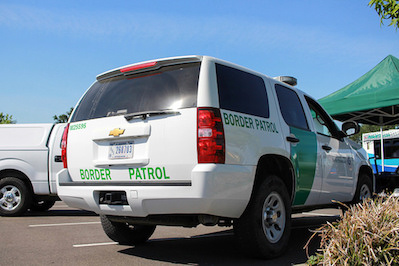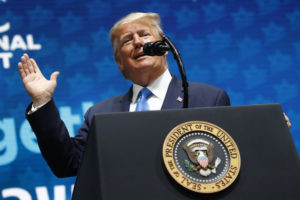No Need to Build Donald Trump’s Wall — Its Logic Is Already Being Practiced
A draconian Border Patrol program may not be Trump's promised structure, but it embodies the logic of his "wall": Either you crossed illegally or you didn’t. And it is just one of many tough U.S. programs developed in recent decades. In the 25 years before Trump's presidential run, the number of Border Patrol agents more than quintupled, from 4,000 to more than 21,000. (_schmal / Public Domain)
1
2
3
4
In the 25 years before Trump's presidential run, the number of Border Patrol agents more than quintupled, from 4,000 to more than 21,000. (_schmal / Public Domain)
1
2
3
4
“Imagine a bulldozer parking in your family graveyard, turning up bones,” Chairman Ned Norris, Jr., of the Tohono O’odham Nation (a Native American tribe whose original land was cut in half by the U.S. border) told Congress in 2008. “This is our reality.”
With a price tag of, on average, $4 million a mile, these border walls, barriers, and fences have proven to be one of the costliest border infrastructure projects undertaken by the United States. For private border contractors, on the other hand, it’s the gift that just keeps on giving. In 2011, for example, the DHS granted Kellogg, Brown, and Root, a subsidiary of Halliburton, one of our “warrior corporations,” a $24.4 million upkeep contract.
In Tucson in early August, Republican vice presidential candidate Mike Pence looked out over a sea of red “Make America Great Again” caps and t-shirts and said, “We will secure our border. Donald Trump will build that wall.” He would be met with roaring applause, even though his statement made no sense at all.
Should Trump actually win, how could he build something that already exists? Indeed, for all practical purposes, the “Great Wall” that Trump talks about may, by January 2017, be as antiquated as the Great Wall of China given the new high-tech surveillance methods now coming on the market. These are being developed in a major way and on a regular basis by a booming border techno-surveillance industry.
The twenty-first-century border is no longer just about walls; it’s about biometrics and drones. It’s about a “layered approach to national security,” given that, as former Border Patrol Chief Mike Fisher has put it, “the international boundary is no longer the first or last line of defense, but one of many.” Hillary Clinton’s promise of “comprehensive immigration reform” — to be introduced within 100 days of her entering the Oval Office — is a much more reliable guide than Trump’s wall to our grim immigration future. If her bill follows the pattern of previous ones, as it surely will, an increasingly weaponized, privatized, high-tech, layered border regime, increasingly dangerous to future Ignacio Sarabias, will continue to be a priority of the federal government.
On the surface, there are important differences between Clinton’s and Trump’s immigration platforms. Trump’s wildly xenophobic comments and declarations are well known, and Clinton claims that she will, among other things, fight for family unity for those forcibly separated by deportation and enact “humane” immigration enforcement. Yet deep down, the policies of the two candidates are far more similar than they might at first appear.
Navigating Donald Trump’s Borderlands Now
That April day, only one bit of information about Ignacio Sarabia’s border crossing to reunite with his wife and newborn child was available at the Tucson federal courthouse. He had entered the United States “near Nogales.” Most likely, he circumvented the wall first started during the Clinton administration, like most immigrants do, by making his way through the potentially treacherous canyons that surround that border town.
If his experience was typical, he probably didn’t have enough water or food, and suffered some physical woe like large, painful blisters on his feet. Certainly, he wasn’t atypical in trying to reunite with loved ones. After all, more than 2.5 million people have been expelled from the country by the Obama administration, an average annual deportation rate of close to 400,000 people. This was, by the way, only possible thanks to laws signed by Bill Clinton in 1996 and meant to burnish his legacy. They vastly expanded the government’s deportation powers.
In 2013 alone, Immigration and Customs Enforcement carried out 72,000 deportations of parents who said that their children were U.S.-born. And many of them are likely to try to cross that dangerous southern border again to reunite with their families.
The enforcement landscape Sarabia faced has changed drastically since that first wall was built in 1994. The post-9/11 border is now both a war zone and a showcase for corporate surveillance. It represents, according to Border Patrol agent Felix Chavez, an “unprecedented deployment of resources,” any of which could have led to Sarabia’s capture. It could have been one of the hundreds of remote video or mobile surveillance systems, or one of the more than 12,000 implanted motion sensors that set off alarms in hidden operational control rooms where agents stare into large monitors.
It could have been the spy towers made by the Israeli company Elbit Systems that spotted him, or Predator B drones built by General Atomics, or VADER radar systems manufactured by the defense giant Northrup Grumman that, like so many similar technologies, have been transported from the battlefields of Afghanistan or Iraq to the U.S. border.
Your support matters…Independent journalism is under threat and overshadowed by heavily funded mainstream media.
You can help level the playing field. Become a member.
Your tax-deductible contribution keeps us digging beneath the headlines to give you thought-provoking, investigative reporting and analysis that unearths what's really happening- without compromise.
Give today to support our courageous, independent journalists.






You need to be a supporter to comment.
There are currently no responses to this article.
Be the first to respond.